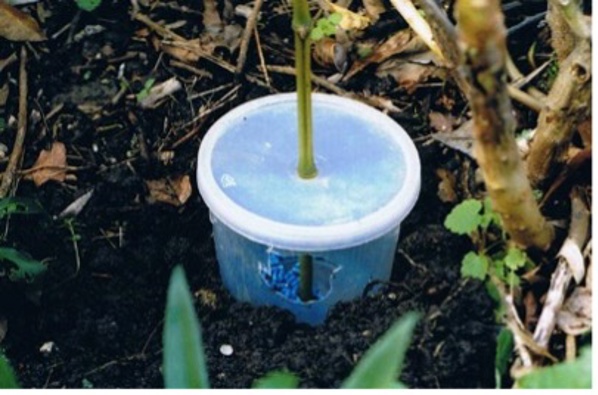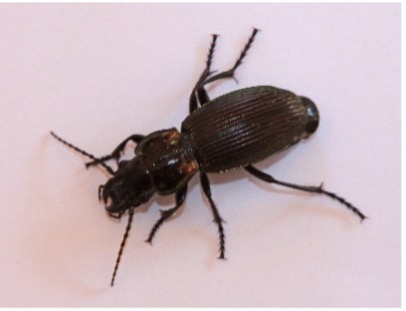Follow
the podcast on


Slugs and snails are a real pest in the garden at this time of the year - moisture and new plant growth encourages them, while egg shell barriers don’t work at all.
Control measures that work:
-
Weed control will expose them to predators such as thrushes. Give your local song thrush an ‘anvil’ to smack the shells of snails on - a large flat (decorative!) rock is perfect.
-
Using bait pellets in a pottle dug into soil. Try a take-away container with the lid on and bait inside. Cut holes in the side of the container to let slugs and snails in but prevent dogs and cats from getting at the bait.
-
An alternative version is to use some off-cuts of plastic waste-pipe - 15-30 cm long and a diameter of 50 to 75 mm. This allows access for slugs and snails but not to birds. Put some bait in the pipes and anchor them down with a heavy brick. They also love to hide in half grapefruit skins (upside-down).
-
Encourage Carabid Beetles (ground beetles) - they often feed on slugs, snail juveniles and eggs.

(Photo / Ruud Kleinpaste)
-
‘Hunt-and-kill evening’ with the kids (at full moon?) – always a good excursion after dinner. Grab a headlight and a bucket to collect them in…night sleuthing! Remember: these hermaphrodites can produce a few hundred eggs each! Reducing populations now makes good sense.
-
Trapping – under cloth, planks and other artificial cover. Slugs and snails love that cover as it increases relative humidity and stops them from drying out.
-
Around the wooden outside of raised beds place a strip of copper foil, almost all the way around, plus a sizeable six-volt battery providing power to both ends of the copper strip. This creates a nice current that they are reluctant to cross and it protects your vegies/seedlings.
In France the brown garden snail (originally from North Africa) is the second-preferred species of escargot for human consumption. Collect the fattest ones and eat them!
That will make you an INVASIVORE.
Escargot - pourquoi pas?
Cantareus aspersus is, to us, an exotic species of snail. It is commonly accepted that it was introduced to New Zealand by the French around the early 1860s. The reason for this is really simple - the brown garden snail is highly prized as escargot in the Mediterranean region. In fact, it has always been the preferred back-up for the slightly larger but closely related vineyard snail (Helix Pomatia).
Recently I read that European populations of Cantareus have become depleted as a result of non-sustainable over-harvesting of wild specimens. These days the species is the subject of heliciculture, the captive rearing of these delicacies, also known as snail farming.
I suppose there may be a few people out there who can set aside the horrific idea of eating invertebrates (quelle horreur!) and who would like to be part of the latest ecological craze of harvesting a truly wonderful resource that yields fat-free, cholesterol-free protein from the comfort of your own back yard.
I have tried this recipe many times and demonstrated it on live television with consenting adults (Good Morning Show) and absolutely wildly enthusiastic kids (What Now?).
- Snail control á la Gourmet involves collecting the finest, fittest and fattest garden snails from the threatened garden areas. Put them in big jars and "starve" them for four to five days on old white bread. This ‘starving’ is an important procedure.
- As you will undoubtedly remember from experiments carried out at your primary school's nature table, the snails have a habit of excreting dark stringy poopy-plops. I think it's time to inform you of the fact that these dark stringy poopy-plops will have to be evacuated from the snail's gut system before cooking, simply because they taste like…yes, they taste rather bad!
- White bread will slowly replace the dark excrement and it improves the taste of the final escargot beyond belief!
- Put a big pot of water on the boil and chuck all these starved snails into the boiling water. Simmer them for about three minutes. Boil the water first before launching the snails - do not over-cook the snails for they will turn out tasting like rubber bands.
- Take the snails out, leave them to cool off otherwise you'll burn your hands.
- Remove the bodies from their long-term residence with eyebrow tweezers or entomological forceps. This is known in the trade as a forceps delivery.
- Fry them for perhaps four to five minutes in some simple garlic butter. Again, do not fry too long because they will turn out like garlic-flavoured rubber bands.
- Recently, Allyson Gofton made a very helpful suggestion to even further improve the culinary effort of our pest control: starve the snails on garlic bread so that they are automatically marinated, alive!
Voilá, this is my recipe for the Bugman's Escargot.
You can serve them in their own shells - remember to make a mental note of which snail came from which shell otherwise fights may break out.
In any case I can recommend them with a 1965 Chateau Tahbilk - they go well together.
Bon Appetit!
LISTEN ABOVE
Take your Radio, Podcasts and Music with you









